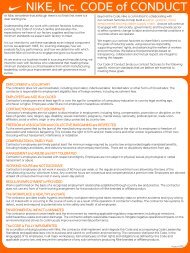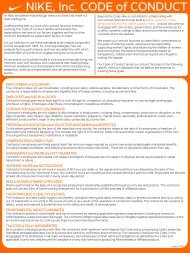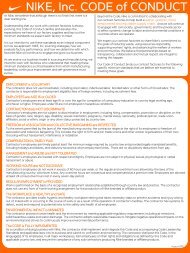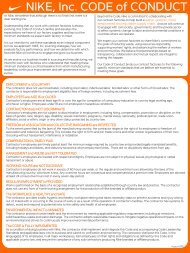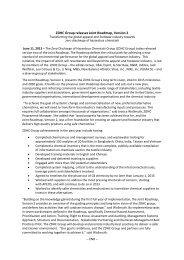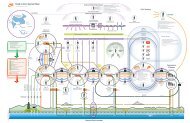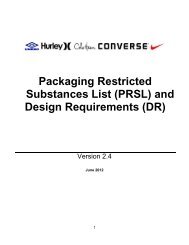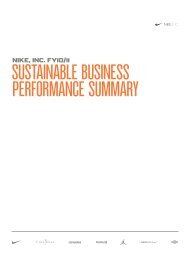COC CLS - Healthy Safety Environment - NIKE, Inc. - The Journey
COC CLS - Healthy Safety Environment - NIKE, Inc. - The Journey
COC CLS - Healthy Safety Environment - NIKE, Inc. - The Journey
Create successful ePaper yourself
Turn your PDF publications into a flip-book with our unique Google optimized e-Paper software.
WASTEWATER<br />
STANDARD<br />
<strong>The</strong> contractor must protect human health and the environment by meeting applicable regulatory<br />
requirements including air emissions, solid/hazardous waste and water discharge. <strong>The</strong> contractor<br />
adopts reasonable measures to mitigate negative operational impacts on the environment and strives<br />
to continuously improve environmental performance.<br />
‣ Develop and implement processes and procedures for the management and discharge of<br />
wastewater. Contractor must comply with requirements as outlined in this standard or relevant<br />
local laws and regulations, whichever is more stringent.<br />
RESPONSIBILITIES<br />
Location Manager must ensure that procedures for the management and discharge of wastewater are<br />
developed, implemented and followed.<br />
HSE Representative must establish, maintain and administer the procedures for wastewater.<br />
Managers and Supervisors must ensure that employees receive training and comply with the<br />
requirements of the processes and procedures for wastewater.<br />
Employees must adhere to the requirements of the processes and procedures for wastewater.<br />
DEFINITIONS<br />
• Wastewater is used water and water-carried solids, including industrial, sanitary and storm water<br />
discharges.<br />
• Industrial wastewater is wastewater from industrial or commercial processes.<br />
• Sanitary wastewater is wastewater from sanitary conveniences, such as toilets, sinks, showers,<br />
laundries.<br />
• Storm water is water generated from precipitation during a storm event.<br />
• Pollution control equipment is any equipment or process that treats wastewater prior to final<br />
discharge. <strong>The</strong> general methods include physical treatment (e.g. – oil/water separators), chemical<br />
treatment (e.g. – pH neutralization) and biological treatment (e.g. – aerators).<br />
• Sludge is solid, semisolid, or liquid residue that is removed during the wastewater treatment process.<br />
Sludge also includes materials removed from septic tanks.<br />
REQUIREMENTS<br />
1. RISK ASSESSMENT—Each facility must have a documented annual risk assessment conducted for<br />
wastewater, which includes as a minimum:<br />
a. Identification of all wastewater discharges, including industrial wastewater, sanitary wastewater<br />
and storm water and related health, safety and environment hazards. <strong>The</strong> inventory must<br />
include discharge points, discharge sources, types and quantities of discharges.<br />
b. Evaluation of risk associated with potential wastewater discharges.<br />
<strong>Environment</strong> <strong>CLS</strong> – Page 1 04.14.10



